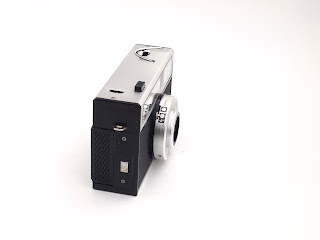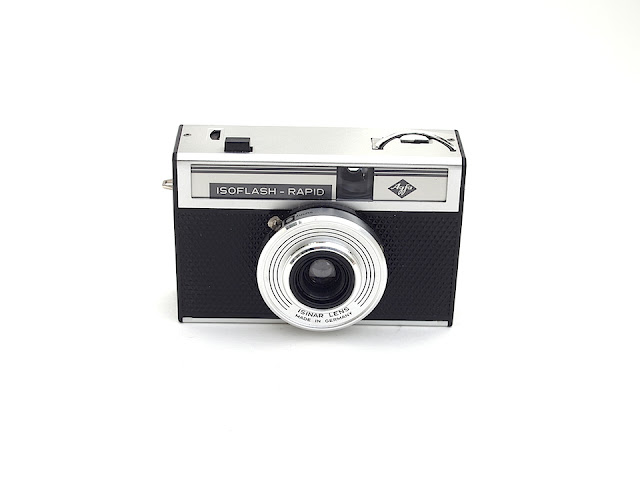Nach so vielen Instamatic (126er) Kameras hier Agfa's Antwort. Vielmehr eher eine Verlegenheitsantwort, denn Kodak hatte Agfa 1963 wohl kalt erwischt. Daher besann man sich bei Agfa ihrer Karat-Kassette aus den 1930ern und spendierte ihr noch eine "Nase" mit der man Kameras die Filmempfindlichkeit mitteilen konnte. 1965 kam das System (wieder) auf den Markt und das gleich mit einer Serie einfacher Kameras aus Agfa's Münchener Kamerawerk. In Größe und Eigenschaftsprofil gleichen die Kameras der Konkurrenz von Kodak doch sehr.
After so many Instamatic (126) cameras, here comes Agfa's answer to this easy-load cartridge. It was rather a stopgap answer, Kodak obviously caught Agfa with their pants down. Agfa remembered its Karat cartridge from the mid 30ies, and just added a nose to convey film speed information to the (equiped) cameras. Agfa (re-) launched the system on the market in 1965 together with a series of simple cameras from their camera production plant in Munich. Size and feature set resemble Kodak's Instamatic versions quite a bit, though.
 |
 |
 |
 |
Ich habe meine Isoflash-Rapid als komplettes Set bei einem Trödelhändler in Astoria, Oregon für nur $20 gefunden. Und es scheint tatsächlich umbenutzt seit 50 Jahren. Der mitgelieferte, originalverpackte Film hat als Ablaufdatum August 1968, die Batterie zum Zünden der Blitzbirnchen ist wohl nicht mehr zu gebrauchen. Neben der ausführlichen Gebrauchsanleitung findet sich noch "easy load instructions" im Inneren der Kamera.
I got my Isoflash-Rapid camera as a complete outfit from an antique store in Astoria, Oregon for just $20. The outfit seems to be unused since 50 years. The roll of film included expired in August 1968, the battery for powering the flash bulbs is probably dead. Besides the comprehensive manual there were "easy load instructions" inside the camera.
Agfa war wohl bewusst, dass wirkliches, idiotensicheres "Easy Load" nur die Kassette von Kodak bot. Rapid war zwar grundsätzlich einfacher zu laden als die 135er Patrone und man brauchte nicht zurückspulen. Allerdings war es schon etwas fummeliger und es bestand immer die Gefahr, dass belichteter Film ein zweites Mal eingelegt werden konnte. Agfa wies daher sehr deutlich auf den größten (und fast einzigen) Nachteil der Instamatik-Kassette hin: die mangelhafte Filmplanlage und den damit verbundenen Schärfeverlust (siehe Bild unten von der Verpackung). Genutzt hat es nichts, denn die billigen und einfachen Kameras mit ihren lichtschwachen Objektiven profitierten ja nicht wirklich von einer Filmandruckplatte. Agfa schwenkte dann auch schon 1968 um, kaufte eine Lizenz von Kodak und stellte selbst Kameras und Film für die 126er Kassette (hier Pak genannt) her. In den frühen 70ern dann sogar sehr erfolgreich mit der Agfamatic Serie, meine erste Kamera war so eine.
Agfa must have known, that real and fool-proof "easy load" was only offered by Kodak's Instamatic cartridge. Obviously, the Rapid film was generally easier to handle than a 135 roll and rewind was not necessary. However, it was more fiddly and there was always the threat that already exposed film could be used a second time. Therefore, Agfa pointed distinctly to the biggest (and almost only) disadvantage of the Kodak cartridge: the insufficient film flatness and the respective loss of sharpness (see picture of the packaging below). It was of no avail. The simple and cheap cameras with their low f-stop lenses from both systems wouldn't really benefit from a film pressure plate. After limited success on the market, Agfa changed their mind already in 1968 and started making film and cameras for the 126 cartridge (named PAK at Agfa). During the early 1970ies they have been quite successful with the Agfamatic series. My very first camera was a Agfamatic 200.
Interessanterweise konnte Agfa einige andere Hersteller überzeugen, auch Kameras für die Rapid-Kassette zu bauen. Es sind sogar einige ganz schicke mit ein bisschen fotografischem Anspruch dabei (z.B. Fujica Rapid S2 oder Minolta 24 Rapid), allerdings keine Spiegelreflex, obwohl einer solchen eine Filmandruckplatte sehr gut gestanden hätte.
Ich werde natürlich das Set in seinem Zustand bewahren und den Film nicht verwenden. Wenn ich aber mal eine zweite Rapid (oder SL) Kassette finde (oder gar einen unbelichteten Film), werde ich wohl richtig fotografieren. 35mm Film läßt sich nämlich recht einfach umspulen, siehe Links unten.
Ich werde natürlich das Set in seinem Zustand bewahren und den Film nicht verwenden. Wenn ich aber mal eine zweite Rapid (oder SL) Kassette finde (oder gar einen unbelichteten Film), werde ich wohl richtig fotografieren. 35mm Film läßt sich nämlich recht einfach umspulen, siehe Links unten.
Interestingly, Agfa was able to convice some other manufacturers to produce own cameras for the format. There are even some really nice with some photographic ambitions (eg. Fujica Rapid S2 oder Minolta 24 Rapid). However, no SLR, although this could have made use of the film pressure plate.
I will of course keep the complete outfit in its actual form and don't use the film. However, if I ever find a second Rapid (or SL) cartridge (or an unexposed film roll), I will shoot a roll with the camera. 35 mm film can be easily reloaded, see links below.
I will of course keep the complete outfit in its actual form and don't use the film. However, if I ever find a second Rapid (or SL) cartridge (or an unexposed film roll), I will shoot a roll with the camera. 35 mm film can be easily reloaded, see links below.
| Datenblatt | einfache Sucherkamera mit für Rapid-Film |
| Objektiv | Agfa Isinar (einlinsiger Meniskus, 40 mm f/8) |
| Verschluss | Agfa Parator (1/40 und 1/80 s) |
| Film (format) | 24 x 24 mm, Agfa Rapid Kassette, 16 Aufnahmen |
| Fokussierung | Fixfocus |
| Sucher | einfacher Sucher ohne Rahmen |
| Blitz | AG-1(B) Blitzbirnchen, versenkbarer Reflektor |
| Filmtransport | mittels Daumenrad, Rückspulen nicht notwendig |
| sonst. Ausstattung | Bildzählwerk (rückwärts), Stativgewinde |
| Maße, Gewicht | |
| Batterie | PX-23 (6V Quecksilber), nur für Blitz notwendig |
| Baujahr(e) | 1965-1966 |
| Kaufpreis, Wert heute | 65 DM, US$15 (1965), $10-$20 |
| Links | Camerosity-Blog, Lomography Magazine |
| Data Sheet | simple point&shoot camera for Rapid film |
| Lens | Agfa Isinar (single lens meniscus, 40 mm f/8) |
| Shutter | Agfa Parator (1/40 and 1/80 s) |
| Film (format) | 24 x 24 mm (1" x 1") |
| Focussing | Fixfocus |
| Viewfinder | simple viewfinder without frame |
| Flash | AG-1(B) flash bulbs, retractable reflector |
| Film advance | with thumb wheel, no rewind necessary |
| misc. Features | frame counter (backwards), tripod socket |
| Size, Weight | |
| Battery | PX-23 (6V Mercury), only to power flash bulbs |
| Year(s) of Production | 1965-1966 |
| Original Price, Today's Value | US$15 (1965), $10-$20 |
| Links | Camerosity-Blog, Lomography Magazine |








